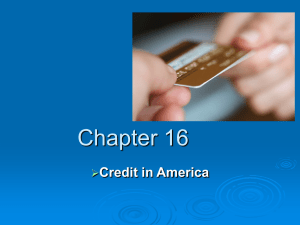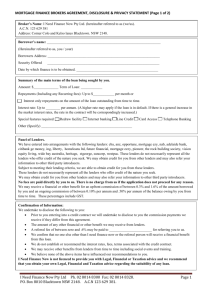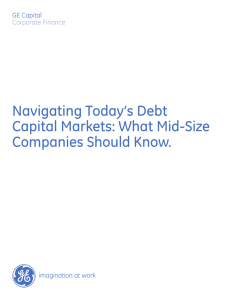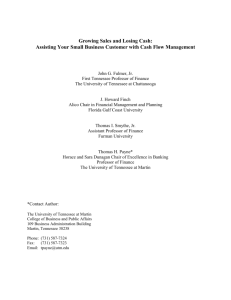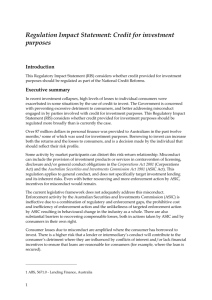Big Data Meets Microfinance
advertisement
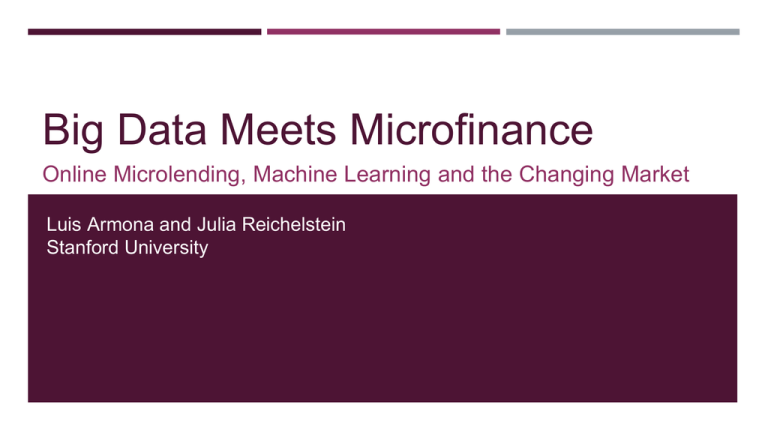
Big Data Meets Microfinance Online Microlending, Machine Learning and the Changing Market Luis Armona and Julia Reichelstein Stanford University A Brief Intro to Machine Learning ◼ Supervised machine learning ◼ Algorithms learn from training examples to discover a relationship between input and output variables ◼ Learning is done purely by trial-and-error ◼ No prior knowledge of data required – these algorithms can be used in any field ◼ See Andrew Ng’s CS 229 Stanford course website for an in-depth treatment of machine learning Framing the Problem ◼ Consider a new MFI with data on 30 previous clients: ◼ X1 : Annual income ◼ X2 : Size of requested loan ◼ The MFI also has data on whether each client paid back the loan or defaulted ◼ Call this output variable Y ◼ Y = 0 if the client paid back the loan (the client was a safe investment choice) ◼ Y = 1 if the client defaulted (the client was too risky) ◼ We will build an algorithm that will take X1 and X2 and calculate a prediction, G Building the Algorithm ◼ Simplest example – Linear regression: G = a + b*X1 + c*X2 ◼ We start with random guesses for the parameters a, b, and c ◼ We make a prediction with these random parameters, then compare the results with the Y values ◼ Our algorithm adjusts the parameters little by little until our predictions, G, match the Y values ◼ We are finding the curve that splits the clients between safe and risky ◼ We can use other equations besides linear – e.g., quadratic, logistic, Gaussian ◼ Often, programmers will try several different equations to find the best one Regression Plot Should We Be Concerned? ◼ Machine learning is a very powerful tool ◼ However, it cannot replace loan officers – big data algorithms can only complement their work ◼ These algorithms are only as good as their input data ◼ Data collection and processing are key ◼ Algorithms can still be unreliable – loan officers are indispensable for their experience and intuition at these times ◼ Still, machine learning will only get better, and traditional MFIs should take heed ◼ Big data’s infiltration into the market will be gradual but steady – be prepared! Examples of Automation- Lendup ◼ Pegs loan fee based on following formula: Fee = 15% amount - $0.30*(30 loan term) ◼ Uses further client info to determine whether they want to disburse the loan ◼ Points System: combines education and loan history with Lendup to increase access to more capital, lower interest, etc. Examples of Automation- Paypal Working Capital ◼ Uses sales history with paypal to determine terms of loan- NO further information ◼ Requires participants to already use Paypal to process transactions ◼ single fixed fee paid off according to monthly sales ◼ Can take out loan of up to 8% of annual sales revenue. Examples of Automation- Prosper ◼ Develops Prosper Rating to determine APR faced by borrower ◼ based on credit score, and prosper rating (indicator of expected losses based on type of loan) ◼ Lists loan request in Peer-to-Peer setting for potential investors displaying terms and relevant info for investor CROWDFUNDING ◼ Analogous to sites like Kickstarter, but for lending to small businesses ◼ Premier example is Kiva Zip ◼ Extremely lucrative for borrowers: ZERO Percent interest ◼ Taps into intangible “feel-good” benefits for lenders ◼ Requires Trustee, but repayment in USA is only about 85% Microloan Requirements Data information of the top players We took a deeper look into… ◼ Lendup ◼ Paypal Working Capital ◼ Sunovis ◼ Mission Asset Fund ◼ Kiva Zip ◼ Lending Club ◼ Biz2credit ◼ Prosper ◼ OnDeck ◼ Smart Biz ◼ Kabbage ◼ Billfloat ◼ Tiny Cat Loans Lending Requirements Credit Score 67% Social Security Number 67% Business Identification (e.g. address or tax forms) 58% Proof of income or business revenue (e.g. bank statements) 83% Reference (at least one) 17% Collateral 0% Comparing Online Lenders to Traditional Lenders- By the Numbers ◼ Online lenders are much younger than traditional lenders- average of 5 years old (compared mean for traditional lenders of 17) ◼ APR: Difficult to measure, but usually much higher ◼ Traditional lender mean: 8% APR; Lendup has APR near 400% for first-time users, despite socially responsible profile ◼ Scale is also massive compared to traditional lenders: Online lenders averaged close to 1 billion $ of loans, compared to 1.2 million $ for traditional lenders ◼ Traditional lenders give out loans typically from $1000 to $50,000, while these online lenders have a much wider range of loans (sometimes as high as $250k) *Traditional Microfinance lender data based on Microtracker.org California 2012 data Conclusion ◼ Big Data makes lending decisions a simple but potentially flawed routine ◼ Allows for massive economies of scale ◼ Customer faces simple and user-friendly interface ◼ Online lenders focus on easily quantifiable data with valuable information (i.e. credit scores) ◼ Offerings and form of loan product differ from firm to firm ◼ P2P vs Fixed Fee vs Other formulas ◼ Traditional microlenders are more limited in their consumer base, but usually offer much friendlier APR due to community-oriented approach



